The May 2023 Rainstorm-Induced Landslides in the Emilia-Romagna Region (Northern Italy): Considerations from UAV Investigations Under Emergency Conditions
Abstract
:1. Introduction
2. General Features of the Study Area
2.1. Geological Setting

2.2. Climatic Setting
2.3. Landslide Types
3. The May 2023 Rainstorms and Related Ground Effects
4. Materials and Methods
4.1. Coordination of Post-Event Activities
4.2. On-Site Activities
4.2.1. UAV Photogrammetric Acquisitions
4.2.2. Field Surveys
5. Results
5.1. UAV-Derived Products
5.2. Main Features of Observed Phenomena During Field Surveys
6. Discussion
7. Conclusions
- Most landslides were shallow and characterized by different kinematics (i.e., rotational and translational failure in the colluvial and residual covers) and often evolved into flows.
- Despite the relatively small volume, the ubiquitous occurrence of such events resulted in uncountable road interruptions, threats to buildings and other structures, and the damming of watercourses leading to further flooding in the innermost valley areas.
- Anthropogenic activities may have influenced triggering mechanisms through the increase in slope gradients, water infiltration, and runoff-generated erosion. In this respect, the absence or poor maintenance of retaining structures and drainage devices (both of surface and underground water) was frequently observed.
- Regardless of potential anthropic influence, the May 2023 landslides can be explained by the high sensitivity of the geological–geotechnical slope settings to the sharp hydraulic changes induced by extreme rainfall intensity. The statistical analysis of historical rainfall records highlights the exceptionality of the two single rainstorms of the 1–3 May and 15–17 May, which increases from east (RPs > 70 years) to west (RPs > 500 years). However, what is more important is the occurrence of two such severe events in the same area in the span of a few days.
- Beyond the exceptionality of the May 2023 rainfall, all the observed landslides occurred in an area characterized by high landslide susceptibility, as testified by the geological and geomorphological setting of the area itself and by the fact that many landslides were located at or close to pre-existing, mapped landslides.
Author Contributions
Funding
Data Availability Statement
Acknowledgments
Conflicts of Interest
Abbreviations
| ARPAE | Regional Agency for Prevention, Environment and Energy of Emilia-Romagna region |
| CNR-IGAG | Research Institute of Environmental Geology and Geoengineering of the Italian National Research Council |
| CNR-IRPI | Research Institute for Geo-Hydrological Protection of the Italian National Research Council |
| DEM | Digital Elevation Model |
| DPC | Civil Protection Department |
| DSM | Digital Surface Model |
| DTM | Digital Terrain Model |
| GCP | Ground Control Point |
| GEV | Generalized Extreme Value |
| GLONASS | GLobal Orbiting NAvigation Satellite System |
| GNSS | Global Navigation Satellite System |
| GSD | Ground Sampling Distance |
| IMU | Initial Measurement Unit |
| ISPRA | Italian Institute for Environmental Protection and Research |
| LiDAR | Light Detection And Ranging |
| PPK | Post Processing Kinematic |
| PWM | Probability Weighted Moment |
| RDN | Rete Dinamica Nazionale |
| RMSE | Root Mean Square Error |
| RP | Return Period |
| RTK | Real Time Kinematic |
| SFM | Structure From Motion |
| UAV | Unmanned Aerial Vehicle |
References
- Tsuchida, T.; Athapaththu, A.M.R.G.; Hanaoka, T.; Kawaguchi, M. Investigation of Landslide Calamity Due to Torrential Rainfall in Shobara City, Japan. Soils Found. 2015, 55, 1305–1317. [Google Scholar] [CrossRef]
- Cascini, L.; Cuomo, S.; Della Sala, M. Spatial and Temporal Occurrence of Rainfall-Induced Shallow Landslides of Flow Type: A Case of Sarno-Quindici, Italy. Geomorphology 2011, 126, 148–158. [Google Scholar] [CrossRef]
- Sarikhan, I.Y.; Stanton, K.D.; Contreras, T.A.; Polenz, M.; Powell, J.; Walsh, T.J.; Logan, R.L. Landslide Reconnaissance Following the Storm Event of December 1–3, 2007, in Western Washington; Open File Report 2008-5; Washington Department of Natural Resources, Division of Geology and Earth Resources: Olympia, WA, USA, 2008; p. 22. Available online: https://file.dnr.wa.gov/publications/ger_ofr2008-5_dec2007_landslides.pdf (accessed on 11 March 2025).
- Bessette-Kirton, E.K.; Coe, J.A.; Schulz, W.H.; Cerovski-Darriau, C.; Einbund, M.M. Mobility Characteristics of Debris Slides and Flows Triggered by Hurricane Maria in Puerto Rico. Landslides 2020, 17, 2795–2809. [Google Scholar] [CrossRef]
- Bucknam, R.C.; Coe, J.A.; Mota Chavarría, M.; Godt, J.W.; Tarr, A.C.; Bradley, L.A.; Rafferty, S.; Hancock, D.; Dart, R.L.; Johnson, M.L. Landslides Triggered by Hurricane Mitch in Guatemala-Inventory and Discussion. USGS Open-File Rep. 2001, 01-443, 38. [Google Scholar] [CrossRef]
- Neuendorf, K.K.E.; Mehl, J.P., Jr.; Jackson, J.A. Glossary of Geology, 5th ed.; American Geosciences Institute: Alexandria, VA, USA, 2011; p. 800. ISBN 9780922152896. [Google Scholar]
- Ellen, S.D.; Wieczorek, G.F. Landslides, floods, and marine effects of the storm of January 3–5, 1982, in the San Francisco Bay Region, California. USGS Prof. Pap. 1988, 1434, 310. [Google Scholar] [CrossRef]
- Larsen, M.C.; Wieczorek, G.F. Geomorphic Effects of Large Debris Flows and Flash Floods, Northern Venezuela, 1999. Z. Fur Geomorphol. Suppl. 2006, 145, 147–175, ISBN 978-3-443-21145-5. [Google Scholar]
- Avelar, A.S.; Coelho Netto, A.L.; Lacerda, W.A.; Becker, L.B.; Mendonça, M.B. Mechanisms of the Recent Catastrophic Landslides in the Mountainous Range of Rio de Janeiro, Brazil. In Proceedings of the Second World Landslide Forum, Rome, Italy, 3–7 October 2011. [Google Scholar]
- Page, M.J.; Rossler, B.J.; Townsend, D.B.; Carey, J.M.; Ries, W.F. Reconnaissance Report on Landsliding Caused by the 19–20 June 2015 Rainstorm in the Taranaki-Wanganui-Manawatu Region. GNS Sci. Rep. 2015, 2015/47, 50. Available online: https://static.geonet.org.nz/info/reports/landslide/SR_2015-047_FINAL.pdf (accessed on 18 September 2024).
- Picarelli, L.; Olivares, L.; Damiano, E.; Darban, R.; Santo, A. The Effects of Extreme Precipitations on Landslide Hazard in the Pyroclastic Deposits of Campania Region: A Review. Landslides 2020, 17, 2343–2358. [Google Scholar] [CrossRef]
- Luino, F.; Turconi, L. Translational Rock-Block Slides in a Tertiary Flyschoid Complexes of Southern Piedmont Region (North-West Italy). In Landslides-Investigation and Monitoring; Ray, R., Lazzari, M., Eds.; IntechOpen: London, UK, 2020; pp. 35–64. [Google Scholar] [CrossRef]
- Lü, Q.; Wu, J.; Liu, Z.; Liao, Z.; Deng, Z. The Fuyang Shallow Landslides Triggered by an Extreme Rainstorm on 22 July 2023 in Zhejiang, China. Landslides 2024, 21, 2725–2740. [Google Scholar] [CrossRef]
- Diwakar, K.C.; Dangi, H.; Naqvi, M.W.; Kadel, S.; Bo Hu, L. Recurring Landslides and Debris Flows near Kalli Village in the Lesser Himalayas of Western Nepal. Geotech. Geol. Eng. 2023, 41, 3151–3168. [Google Scholar] [CrossRef]
- Guo, F.; Meng, X.; Qi, T.; Dijkstra, T.; Thorkildsen, J.K.; Yue, D.; Chen, G.; Zhang, Y.; Dou, X.; Shi, P. Rapid Onset Hazards, Fault-Controlled Landslides and Multi-Method Emergency Decision-Making. J. Mt. Sci. 2022, 19, 1357–1369. [Google Scholar] [CrossRef]
- Mercuri, M.; Biondino, D.; Ciurleo, M.; Cofone, G.; Conforti, M.; Gullà, G.; Stellato, M.C.; Borrelli, L. The Use of an Unmanned Aerial Vehicle (UAV) for First-Failure Landslide Detection. GeoHazards 2024, 5, 683–699. [Google Scholar] [CrossRef]
- Franke, K.W.; Lingwall, B.N.; Zimmaro, P.; Kayen, R.E.; Tommasi, P.; Chiabrando, F.; Santo, A. Phased Reconnaissance Approach to Documenting Landslides Following the 2016 Central Italy Earthquakes. Earthq. Spectra 2018, 34, 1693–1719. [Google Scholar] [CrossRef]
- Liang, R.; Dai, K.; Shi, X.; Guo, B.; Dong, X.; Liang, F.; Tomás, R.; Wen, N.; Fan, X. Automated Mapping of Ms 7.0 Jiuzhaigou Earthquake (China) Post-Disaster Landslides Based on High-Resolution UAV Imagery. Remote Sens. 2021, 13, 1330. [Google Scholar] [CrossRef]
- Esposito, G.; Petrucci, O. Landslide Hazard and Risk Assessment for Civil Protection Early Response. In Understanding and Reducing Landslide Disaster Risk; Sassa, K., Mikoš, M., Sassa, S., Bobrowsky, P.T., Takara, K., Dang, K., Eds.; ICL Contribution to Landslide Disaster Risk Reduction; Springer International Publishing: Cham, Switzerland, 2021; pp. 513–518. ISBN 978-3-030-60195-9. [Google Scholar]
- Schilirò, L.; De Blasio, F.V.; Esposito, C.; Scarascia Mugnozza, G. Reconstruction of a Destructive Debris-flow Event via Numerical Modeling: The Role of Valley Geometry on Flow Dynamics. Earth Surf. Process. Landf. 2015, 40, 1847–1861. [Google Scholar] [CrossRef]
- Ricci Lucchi, F. The Oligocene to Recent Foreland Basins of the Northern Apennines. In Foreland Basins; Allen, P.A., Homewood, P., Eds.; Blackwell Scientific Publications: Oxford, UK, 1986; Volume 8, pp. 105–140. [Google Scholar] [CrossRef]
- Ori, G.G. Continental Depositional Systems of the Quaternary of the Po Plain (Northern Italy). Sediment. Geol. 1993, 83, 1–14. [Google Scholar] [CrossRef]
- Conti, P.; Cornamusini, G.; Carmignani, L. An Outline of the Geology of the Northern Apennines (Italy), with Geological Map at 1:250,000 Scale. IJG 2020, 139, 149–194. [Google Scholar] [CrossRef]
- Doglioni, C. A Proposal for the Kinematic Modelling of W-dipping Subductions-Possible Applications to the Tyrrhenian-Apennines System. Terra Nova 1991, 3, 423–434. [Google Scholar] [CrossRef]
- Tarquini, S.; Isola, I.; Favalli, M.; Battistini, A.; Dotta, G. TINITALY, a Digital Elevation Model of Italy with a 10 Meters Cell Size (Version 1.1); Istituto Nazionale di Geofisica e Vulcanologia (INGV): Rome, Italy, 2023. [Google Scholar] [CrossRef]
- Kottek, M.; Grieser, J.; Beck, C.; Rudolf, B.; Rubel, F. World Map of the Köppen-Geiger Climate Classification Updated. Metz 2006, 15, 259–263. [Google Scholar] [CrossRef]
- Nistor, M.M. Spatial Distribution of Climate Indices in the Emilia-Romagna Region. Meteorol. Appl. 2016, 23, 304–313. [Google Scholar] [CrossRef]
- Piacentini, D.; Troiani, F.; Daniele, G.; Pizziolo, M. Historical Geospatial Database for Landslide Analysis: The Catalogue of Landslide OCcurrences in the Emilia-Romagna Region (CLOCkER). Landslides 2018, 15, 811–822. [Google Scholar] [CrossRef]
- Annali Idrologici 1939 Parte Seconda, Bacini con Foce al Litorale Adriatico dal Reno al Tronto. Ministero dei Lavori Pubblici, Rome, Italy. Available online: https://www.arpae.it/it/temi-ambientali/meteo/report-meteo/annali-idrologici/annali-idrologici-1939/view (accessed on 12 September 2023).
- Pizziolo, M.; Bernardi, M.; Daniele, G.; Generali, M.; Piacentini, D. Landslide Occurrences During the High-Intensity Rainfall Event of March–April 2013 in the Emilia-Romagna Region (North Apennines, Italy). In Engineering Geology for Society and Territory-Volume 5; Lollino, G., Manconi, A., Guzzetti, F., Culshaw, M., Bobrowsky, P., Luino, F., Eds.; Springer International Publishing: Cham, Switzerland, 2015; pp. 777–780. [Google Scholar] [CrossRef]
- Gatto, M.P.A. Incorporating Rainfall Forecast Data in X-SLIP Platform to Predict the Triggering of Rainfall-Induced Shallow Landslides in Real Time. Geosciences 2023, 13, 215. [Google Scholar] [CrossRef]
- Bertolini, G.; Guida, M.; Pizziolo, M. Landslides in Emilia-Romagna Region (Italy): Strategies for Hazard Assessment and Risk Management. Landslides 2005, 2, 302–312. [Google Scholar] [CrossRef]
- Rossi, M.; Witt, A.; Guzzetti, F.; Malamud, B.D.; Peruccacci, S. Analysis of Historical Landslide Time Series in the Emilia-Romagna Region, Northern Italy. Earth Surf. Process. Landf. 2010, 35, 1123–1137. [Google Scholar] [CrossRef]
- Segoni, S.; Lagomarsino, D.; Fanti, R.; Moretti, S.; Casagli, N. Integration of Rainfall Thresholds and Susceptibility Maps in the Emilia Romagna (Italy) Regional-Scale Landslide Warning System. Landslides 2015, 12, 773–785. [Google Scholar] [CrossRef]
- ARPAE-Regional Agency for Prevention, Environment and Energy of Emilia-Romagna region. L’evento Meteo Idrogeologico e Idraulico del 16–18 Maggio 2023. Available online: https://www.arpae.it/it/notizie/analisi-evento-16-18-maggio-2023.pdf (accessed on 10 December 2023).
- Copernicus Emergency Management Service. Flood in Emilia-Romagna, Italy. EMSN154 Technical Report. Available online: https://emergency.copernicus.eu/mapping/list-of-components/EMSN154 (accessed on 10 December 2023).
- CIMA Research Foundation-International Center for Environmental Monitoring. Italian Flood of May 2023: A Scientific Analysis. Available online: https://www.cimafoundation.org/en/news/the-italian-floods-of-may-2023-a-scientific-analysis/ (accessed on 10 December 2023).
- Guy Carpenter. Post Event Report: 2023 Mid-May Emilia-Romagna Flood. Available online: https://www.guycarp.com/insights/2023/06/Italy_Emilia-Romagna_Flood_2023-05.html (accessed on 10 December 2023).
- Copernicus Emergency Management Service. Landslide Delineation and Volume Estimation in Emilia-Romagna, Italy. EMSN156 Technical Report. Available online: https://emergency.copernicus.eu/mapping/list-of-components/EMSN156 (accessed on 12 September 2023).
- Ferrario, M.F.; Livio, F. Rapid Mapping of Landslides Induced by Heavy Rainfall in the Emilia-Romagna (Italy) Region in May 2023. Remote Sens. 2023, 16, 122. [Google Scholar] [CrossRef]
- Westoby, M.J.; Brasington, J.; Glasser, N.F.; Hambrey, M.J.; Reynolds, J.M. ‘Structure-from-Motion’ Photogrammetry: A Low-Cost, Effective Tool for Geoscience Applications. Geomorphology 2012, 179, 300–314. [Google Scholar] [CrossRef]
- Tomasello, A.; Bosman, A.; Signa, G.; Rende, S.F.; Andolina, C.; Cilluffo, G.; Cassetti, F.P.; Mazzola, A.; Calvo, S.; Randazzo, G.; et al. 3D-Reconstruction of a Giant Posidonia Oceanica Beach Wrack (Banquette): Sizing Biomass, Carbon and Nutrient Stocks by Combining Field Data With High-Resolution UAV Photogrammetry. Front. Mar. Sci. 2022, 9, 903138. [Google Scholar] [CrossRef]
- Anzidei, M.; Trippanera, D.; Bosman, A.; Martin, F.F.; Doumaz, F.; Vecchio, A.; Serpelloni, E.; Alberti, T.; Rende, S.F.; Greco, M. Relative Sea-Level Rise Projections and Flooding Scenarios for 2150 CE for the Island of Ustica (Southern Tyrrhenian Sea, Italy). J. Mar. Sci. Eng. 2023, 11, 2013. [Google Scholar] [CrossRef]
- Sidle, R.C.; Ghestem, M.; Stokes, A. Epic Landslide Erosion from Mountain Roads in Yunnan, China—Challenges for Sustainable Development. Nat. Hazards Earth Syst. Sci. 2014, 14, 3093–3104. [Google Scholar] [CrossRef]
- Lembo Fazio, A.; Ribacchi, R.; Tommasi, P. Sheared Bedding Joints in Rock Engineering: Two Case Histories in Italy. In Rock Joints, Proceedings of the International Symposium on Rock Joints, Loen, Norway, 4–6 June 1990; Barton, N., Stephansson, O., Eds.; Balkema: Rotterdam, The Netherlands, 1990; pp. 83–90. ISBN 9061911095. [Google Scholar]
- Jenkinson, A.F. The Frequency Distribution of the Annual Maximum (or Minimum) Values of Meteorological Elements. Quart. J. R. Meteoro. Soc. 1955, 81, 158–171. [Google Scholar] [CrossRef]
- Hossain, I.; Khastagir, A.; Aktar, M.N.; Imteaz, M.A. Assessment of Extreme Climatic Event Model Parameters Estimation Techniques: A Case Study Using Tasmanian Extreme Rainfall. Environ. Earth. Sci. 2021, 80, 518. [Google Scholar] [CrossRef]
- Hosking, J.R.M.; Wallis, J.R.; Wood, E.F. Estimation of the Generalized Extreme-Value Distribution by the Method of Probability-Weighted Moments. Technometrics 1985, 27, 251–261. [Google Scholar] [CrossRef]
- Antolini, G.; Auteri, L.; Pavan, V.; Tomei, F.; Tomozeiu, R.; Marletto, V. A Daily High-Resolution Gridded Climatic Data Set for Emilia-Romagna, Italy, during 1961–2010. Int. J. Climatol. 2016, 36, 1970–1986. [Google Scholar] [CrossRef]
- Alessi, D.; Bozzano, F.; Di Lisa, A.; Esposito, C.; Fantini, A.; Loffredo, A.; Martino, S.; Mele, F.; Moretto, S.; Noviello, A.; et al. Geological Risks in Large Cities: The Landslides Triggered in the City of Rome (Italy) by the Rainfall of 31 January–2 February 2014. Ital. J. Eng. Geol. Environ. 2014, 1, 15–34. [Google Scholar] [CrossRef]
- Schilirò, L.; Cevasco, A.; Esposito, C.; Mugnozza, G.S. Shallow Landslide Initiation on Terraced Slopes: Inferences from a Physically Based Approach. Geomat. Nat. Hazards Risk 2018, 9, 295–324. [Google Scholar] [CrossRef]
- Froude, M.J.; Petley, D.N. Global Fatal Landslide Occurrence from 2004 to 2016. Nat. Hazards Earth Syst. Sci. 2018, 18, 2161–2181. [Google Scholar] [CrossRef]
- Haque, U.; da Silva, P.F.; Devoli, G.; Pilz, J.; Zhao, B.; Khaloua, A.; Wilopo, W.; Andersen, P.; Lu, P.; Lee, J.; et al. The Human Cost of Global Warming: Deadly Landslides and Their Triggers (1995–2014). Sci. Total Environ. 2019, 682, 673–684. [Google Scholar] [CrossRef]
- Martina, M.L.V.; Berti, M.; Simoni, A.; Todini, E.; Pignone, S. Un Approccio Bayesiano per Individuare le Soglie di Innesco delle Frane. In Rainfall-Induced Landslides: Mechanisms, Monitoring Techniques and Nowcasting Models for Early Warning Systems, Volume 2; Picarelli, L., Tommasi, P., Urcioli, G., Versace, P., Eds.; CIRAM: Naples, Italy, 2009. [Google Scholar]
- Schilirò, L.; Marmoni, G.M.; Fiorucci, M.; Pecci, M.; Mugnozza, G.S. Preliminary Insights from Hydrological Field Monitoring for the Evaluation of Landslide Triggering Conditions over Large Areas. Nat. Hazards 2023, 118, 1401–1426. [Google Scholar] [CrossRef]
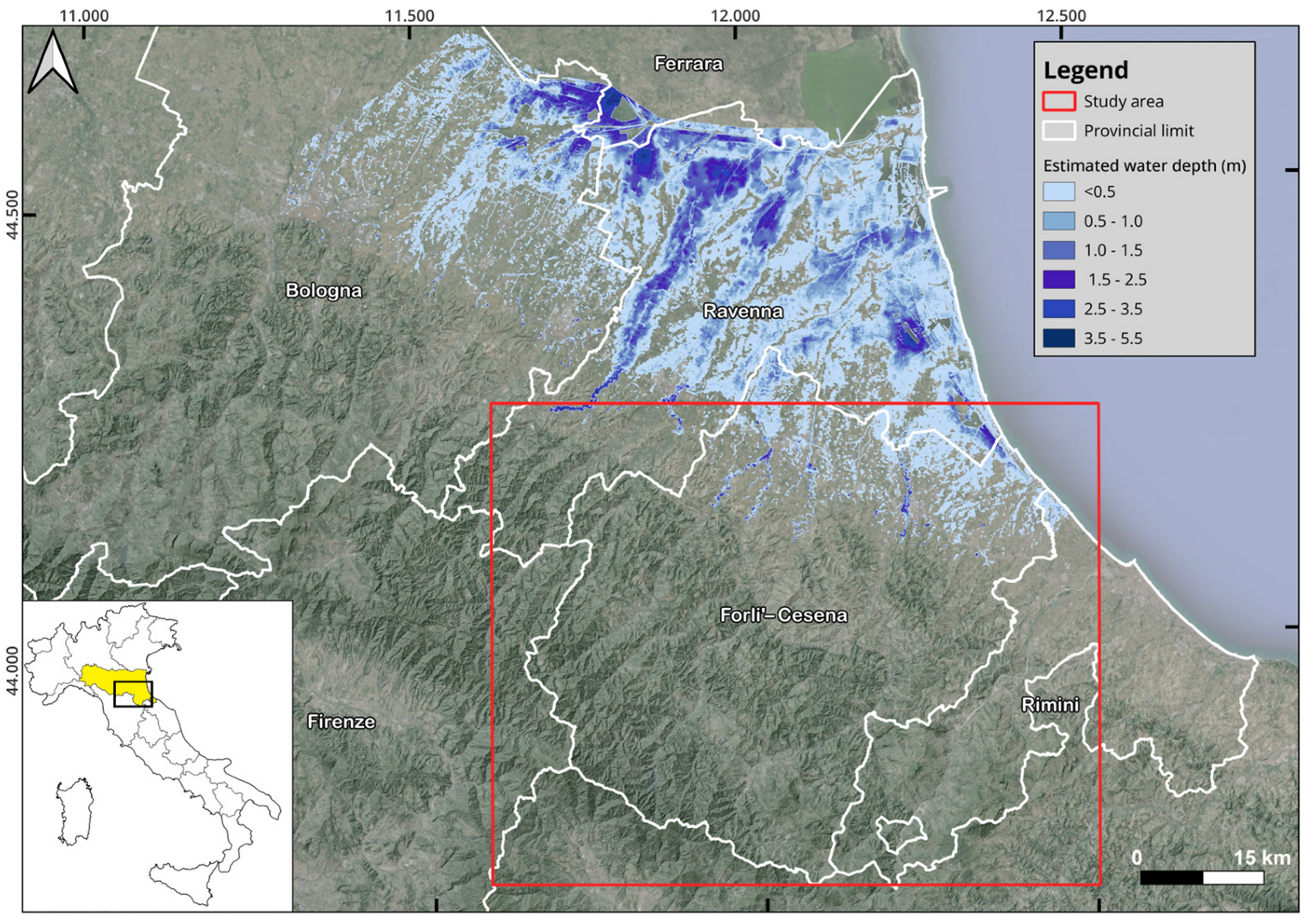
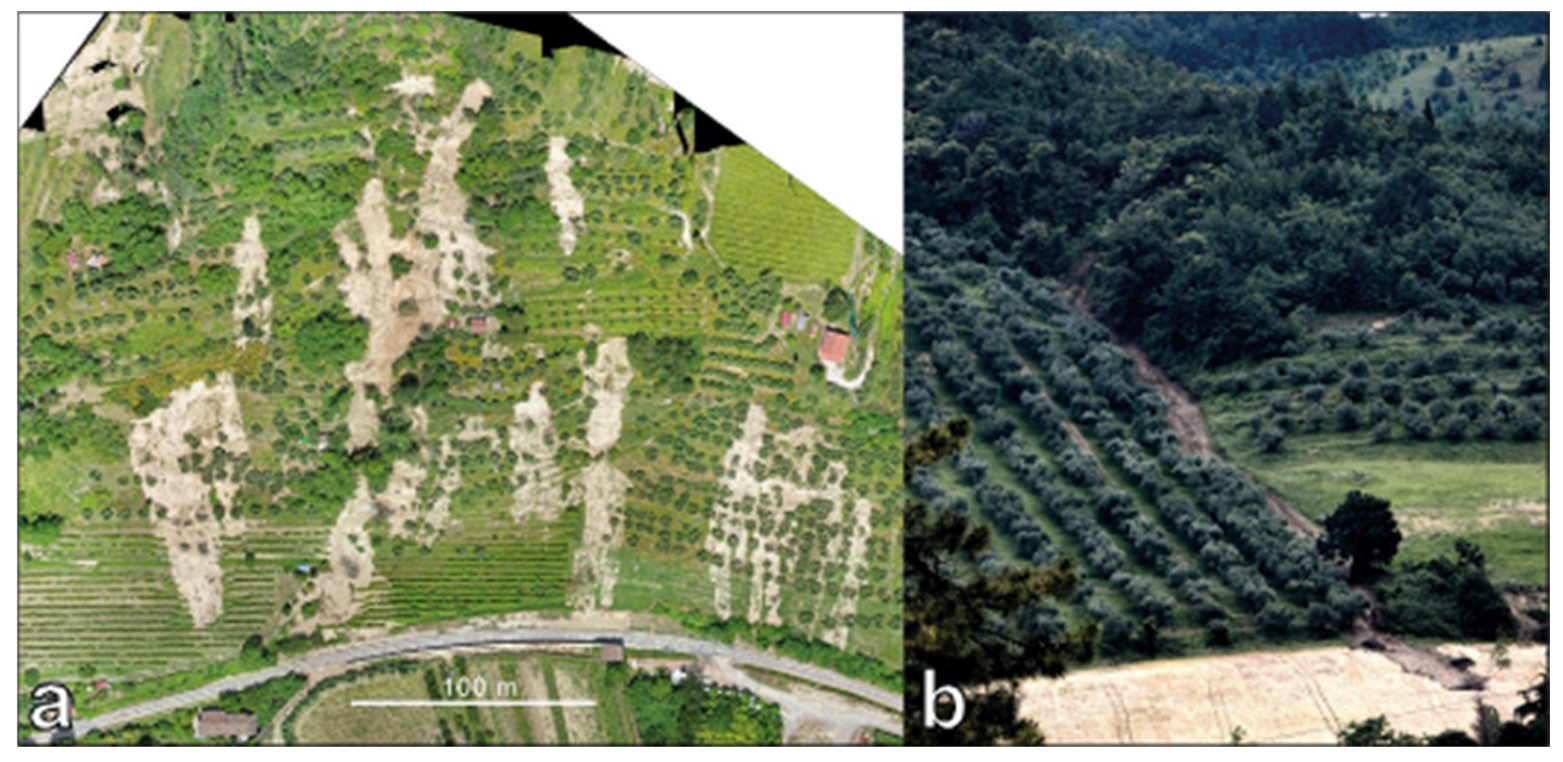
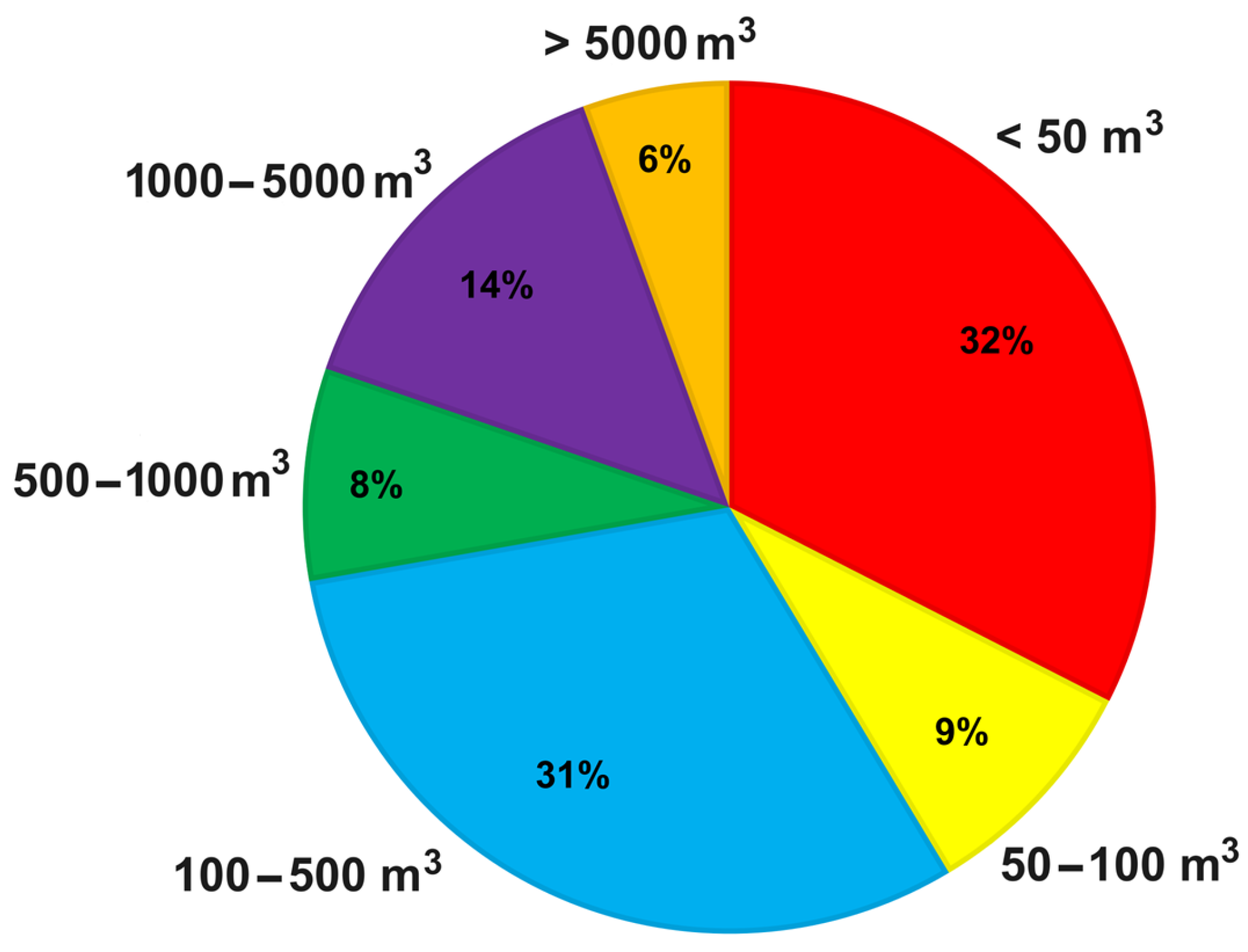
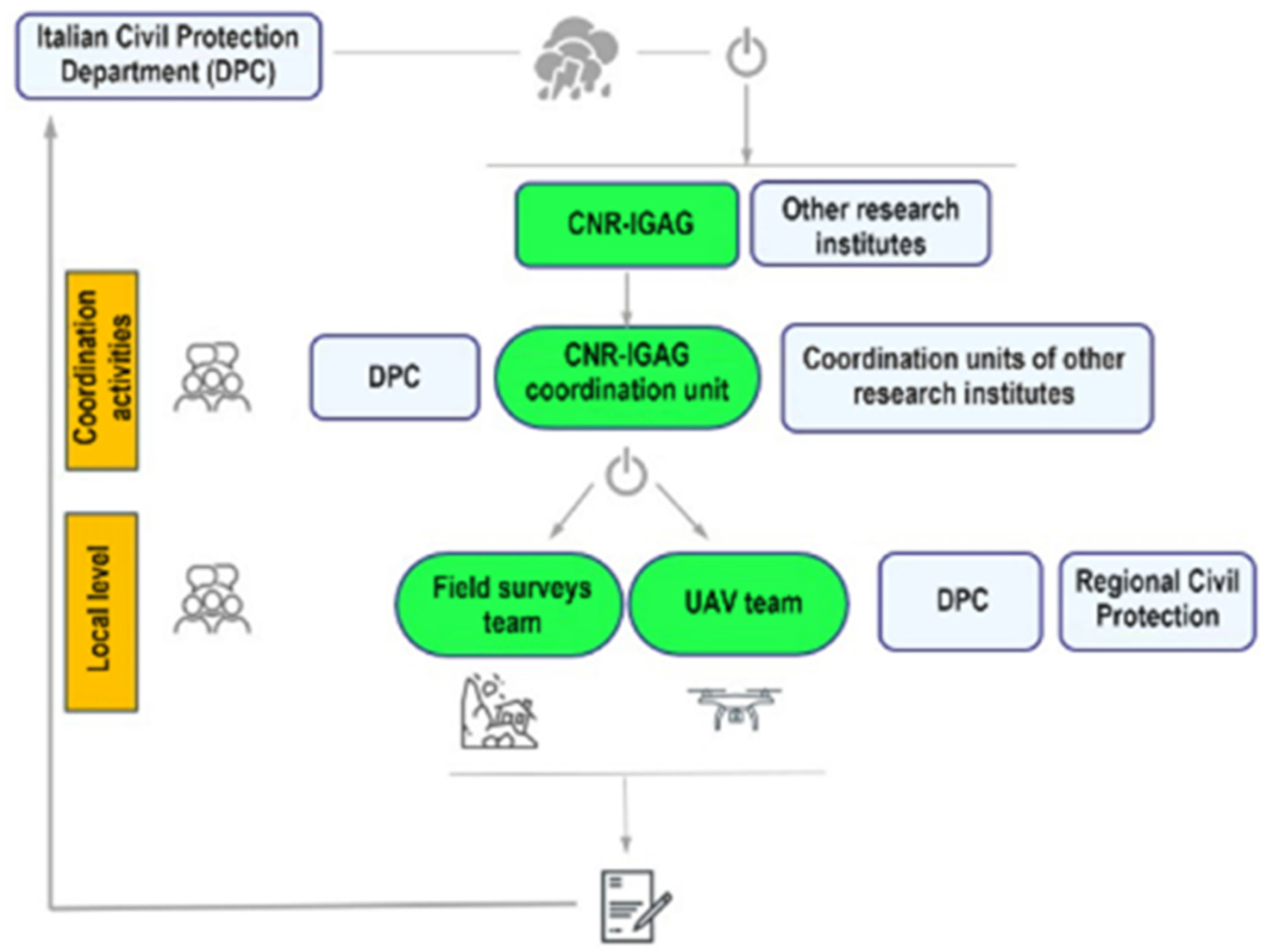
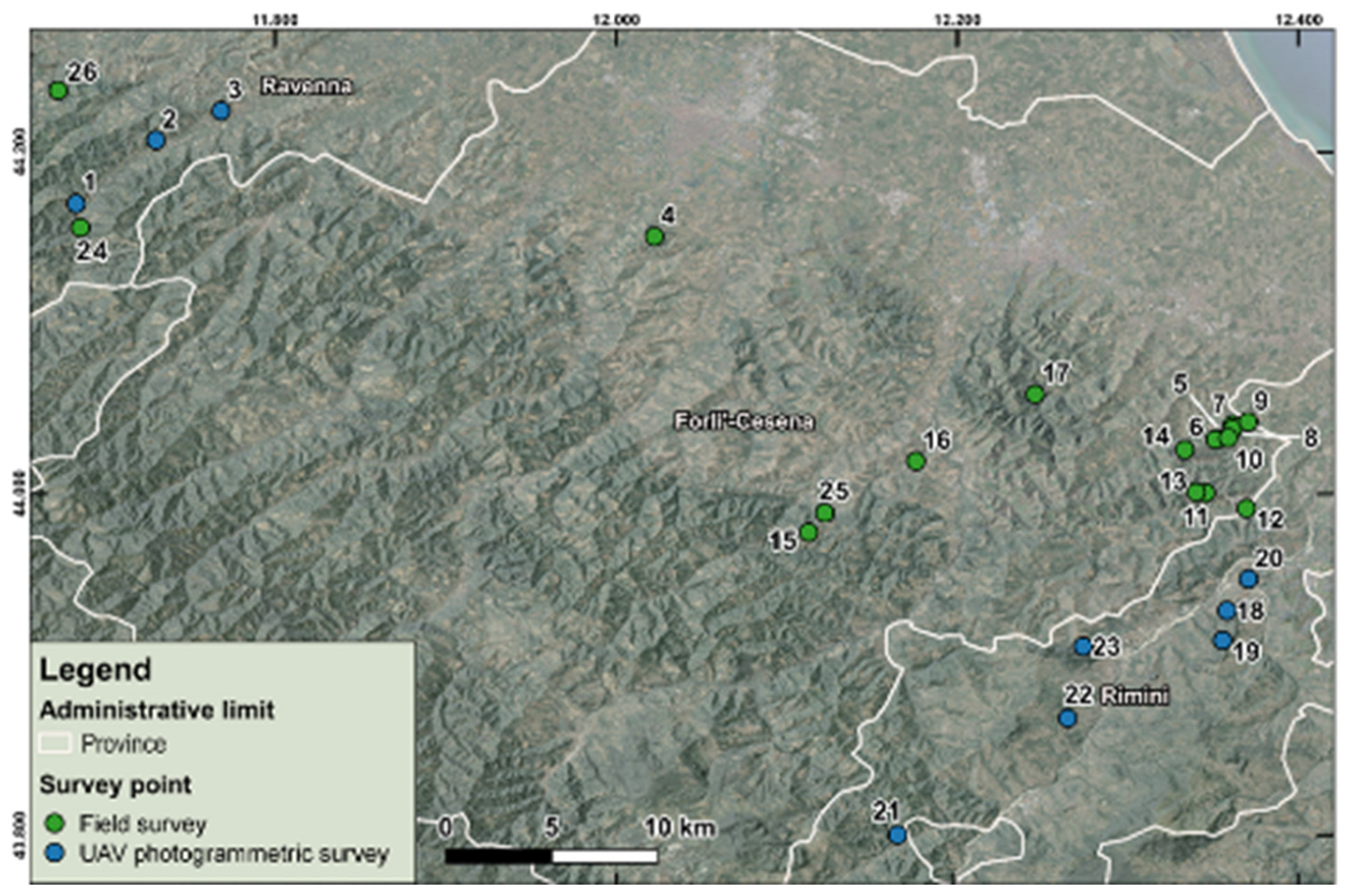

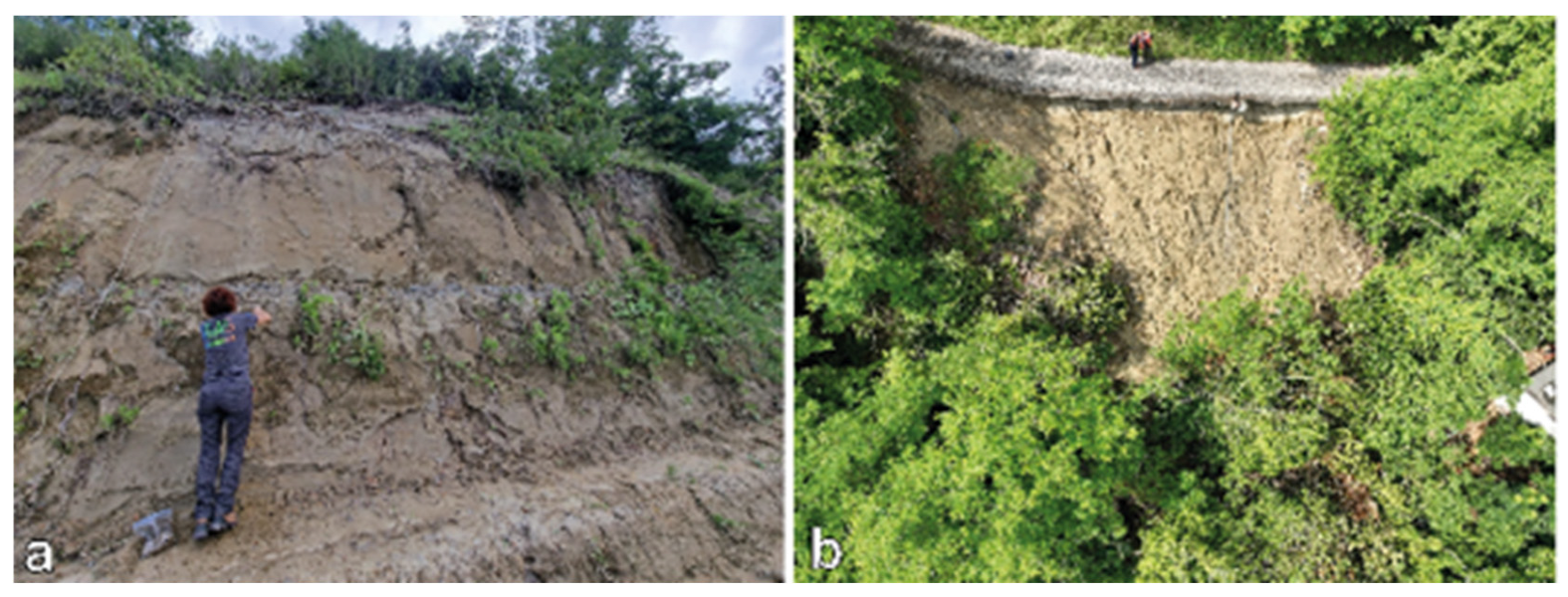
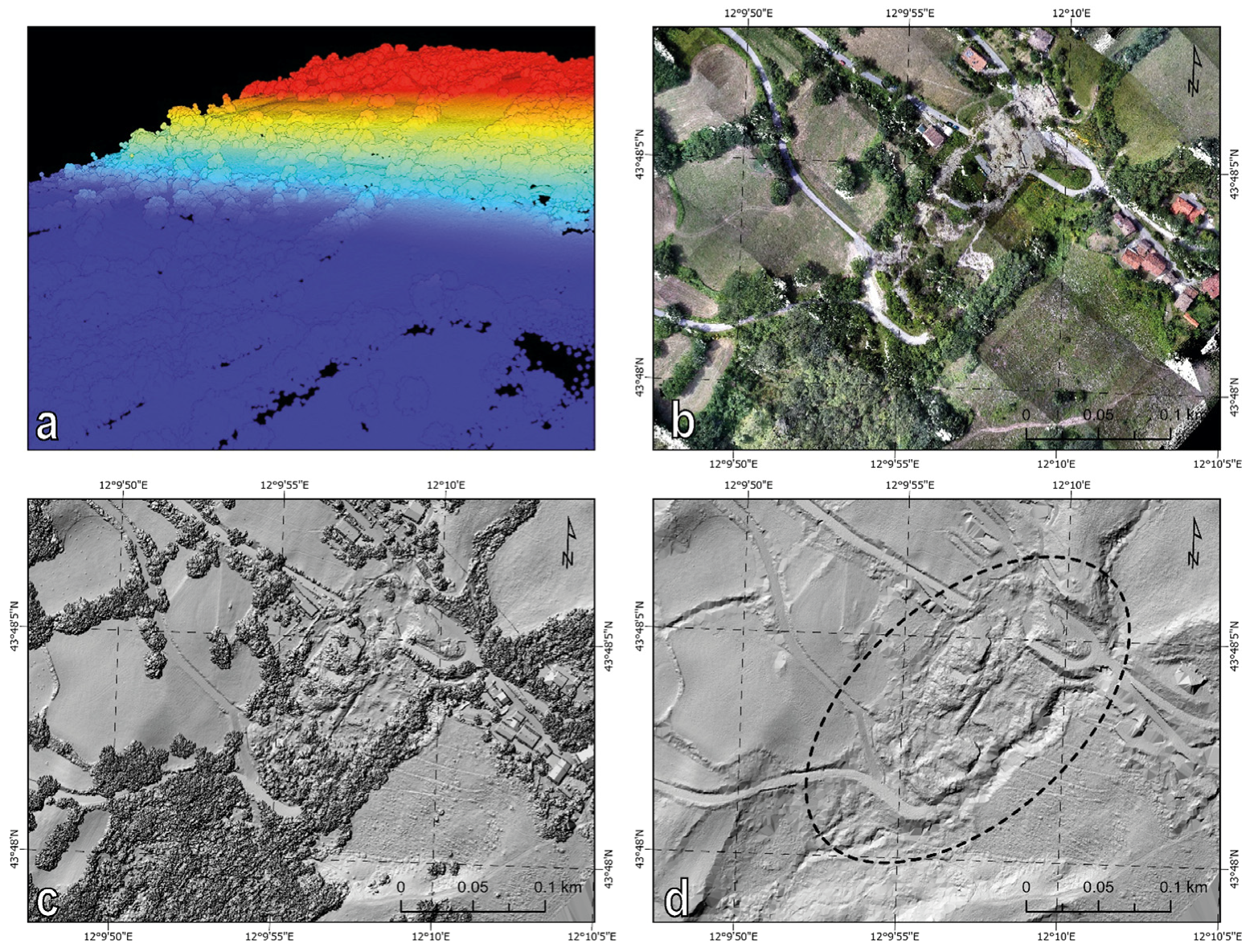
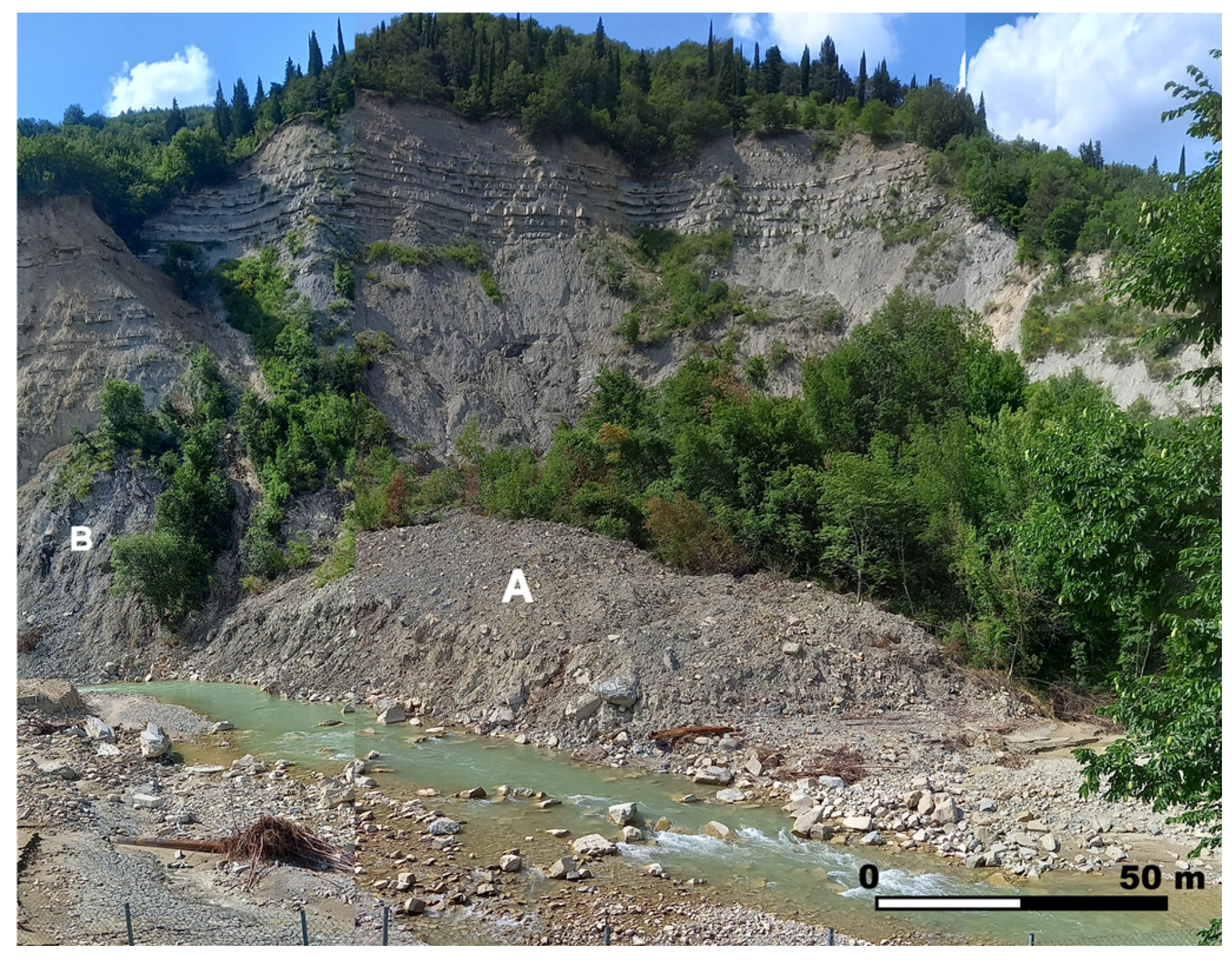



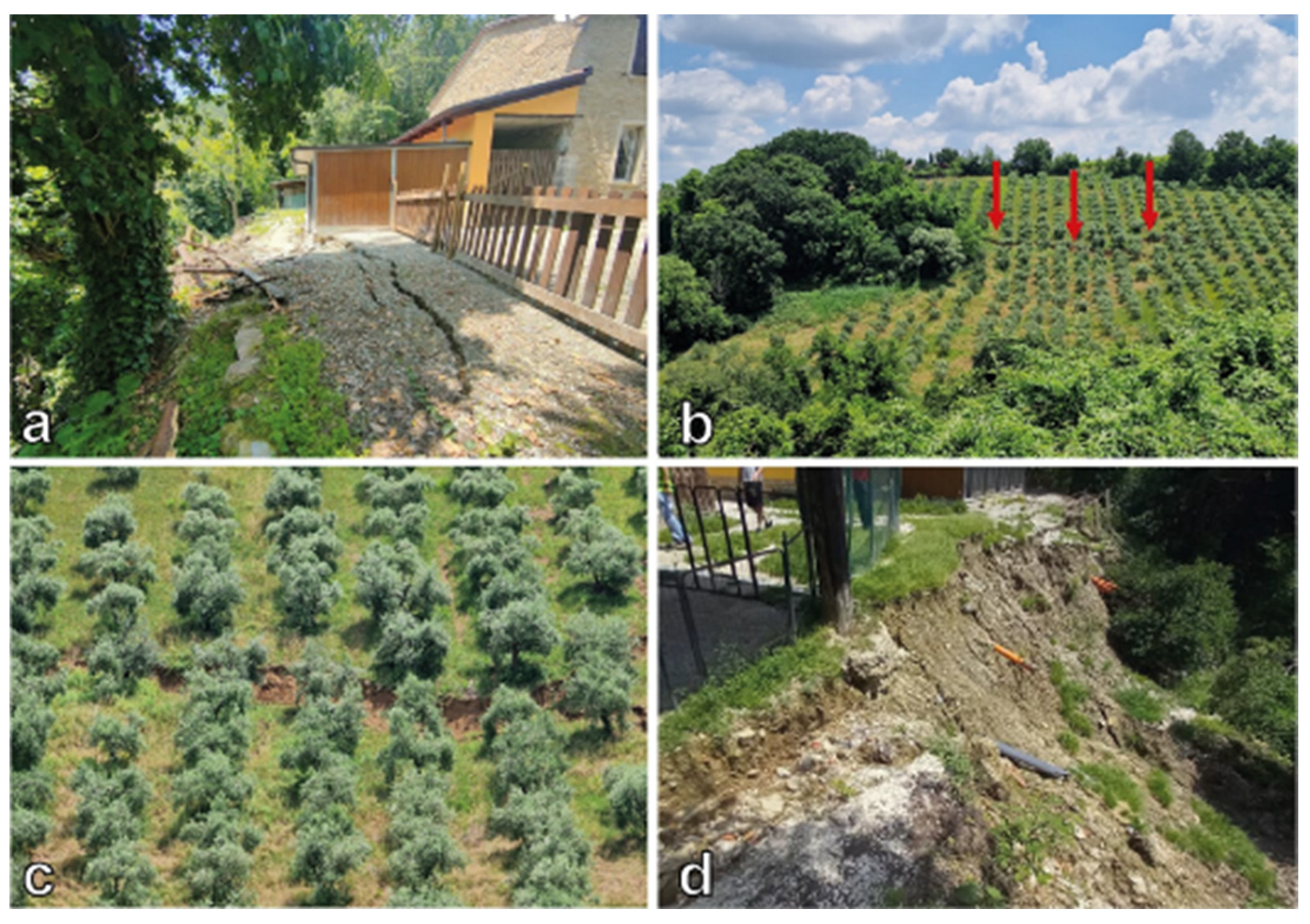

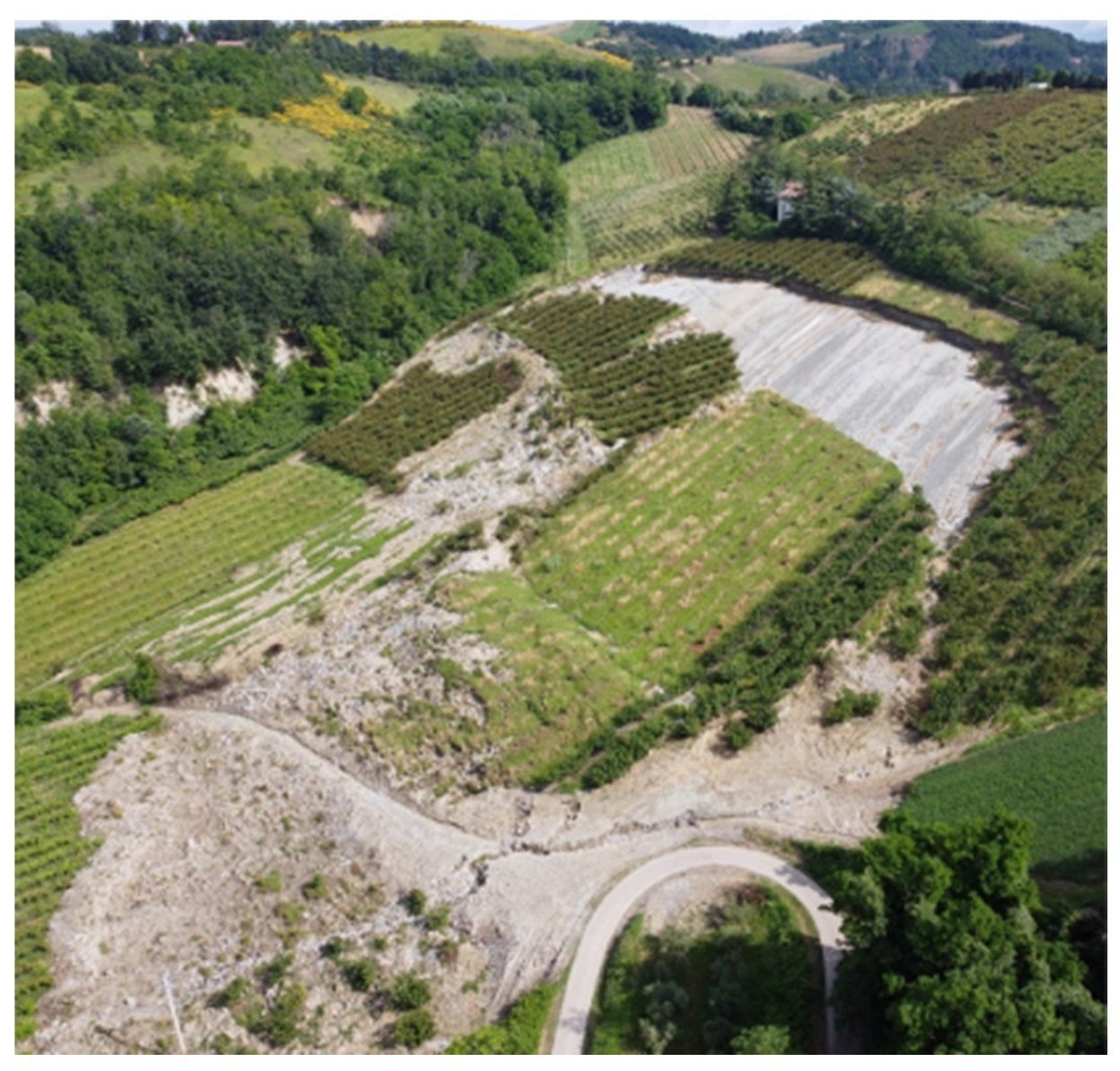
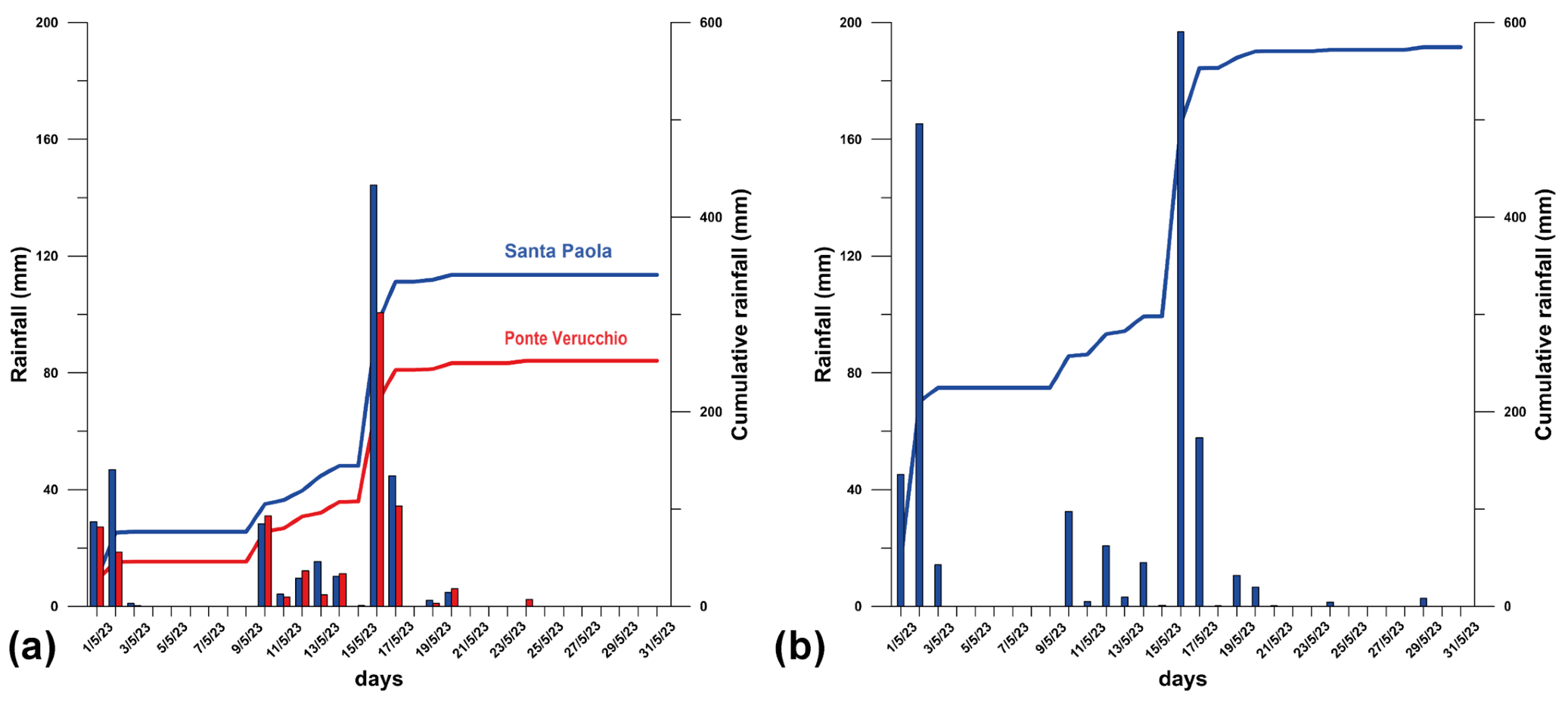
| Reference Time | Rainfall Santa Paola (278 m a.s.l.) | RP | Rainfall Ponte Verucchio (116 m a.s.l.) | RP |
|---|---|---|---|---|
| (days) | (mm) | (years) | (mm) | (years) |
| 2 | 189.2 | 77 | 135 | 15 |
| 5 | 214.8 | 76 | 150.6 | 10 |
| 10 | 257 | 48 | 197 | 13 |
| 20 | 333.8 | 71 | 243 | 12 |
| 30 | 339.2 | 24 | 255.8 | 6 |
| 60 | 369.4 | 6 | 291.8 | 2 |
| 90 | 482 | 6 | 386.8 | 2 |
| 120 | 613.6 | 9 | 554.4 | 4 |
| 180 | 773.6 | 7 | 707 | 4 |
| Reference Time | Rainfall Santa Paola | RP |
|---|---|---|
| (hours) | (mm) | (years) |
| 1 | 22 | 5 |
| 3 | 44.6 | 10 |
| 6 | 67.8 | 13 |
| 12 | 88 | 13 |
| 24 | 168.4 | >100 |
| 48 | 189.2 | 56 |
| Reference Time | Rainfall May 1st–2nd | RP | Rainfall May 16th–17th | RP |
|---|---|---|---|---|
| (days) | (mm) | (years) | (mm) | (years) |
| 2 | 210.6 | >500 | 254.6 | >500 |
| 5 | 210.8 | 66 | 273.2 | >300 |
| 10 | 225.2 | 23 | 328.2 | >200 |
| 20 | 242 | 11 | 553.2 | >1000 |
| 30 | 247 | 4 | 571.2 | >1000 |
| 60 | 293.2 | 2 | 620.4 | >1000 |
| 90 | 395 | 2 | 737.2 | >1000 |
| 120 | 522.4 | 2 | 829.4 | >500 |
| 180 | 573 | 1 | 932 | >500 |
Disclaimer/Publisher’s Note: The statements, opinions and data contained in all publications are solely those of the individual author(s) and contributor(s) and not of MDPI and/or the editor(s). MDPI and/or the editor(s) disclaim responsibility for any injury to people or property resulting from any ideas, methods, instructions or products referred to in the content. |
© 2025 by the authors. Licensee MDPI, Basel, Switzerland. This article is an open access article distributed under the terms and conditions of the Creative Commons Attribution (CC BY) license (https://creativecommons.org/licenses/by/4.0/).
Share and Cite
Schilirò, L.; Bosman, A.; Caielli, G.M.; Corazza, A.; Crema, S.; Di Salvo, C.; Gaudiosi, I.; Mancini, M.; Norini, G.; Peronace, E.; et al. The May 2023 Rainstorm-Induced Landslides in the Emilia-Romagna Region (Northern Italy): Considerations from UAV Investigations Under Emergency Conditions. Geosciences 2025, 15, 101. https://doi.org/10.3390/geosciences15030101
Schilirò L, Bosman A, Caielli GM, Corazza A, Crema S, Di Salvo C, Gaudiosi I, Mancini M, Norini G, Peronace E, et al. The May 2023 Rainstorm-Induced Landslides in the Emilia-Romagna Region (Northern Italy): Considerations from UAV Investigations Under Emergency Conditions. Geosciences. 2025; 15(3):101. https://doi.org/10.3390/geosciences15030101
Chicago/Turabian StyleSchilirò, Luca, Alessandro Bosman, Grazia Maria Caielli, Angelo Corazza, Stefano Crema, Cristina Di Salvo, Iolanda Gaudiosi, Marco Mancini, Gianluca Norini, Edoardo Peronace, and et al. 2025. "The May 2023 Rainstorm-Induced Landslides in the Emilia-Romagna Region (Northern Italy): Considerations from UAV Investigations Under Emergency Conditions" Geosciences 15, no. 3: 101. https://doi.org/10.3390/geosciences15030101
APA StyleSchilirò, L., Bosman, A., Caielli, G. M., Corazza, A., Crema, S., Di Salvo, C., Gaudiosi, I., Mancini, M., Norini, G., Peronace, E., Polpetta, F., Simionato, M., Stigliano, F., Varone, C., & Tommasi, P. (2025). The May 2023 Rainstorm-Induced Landslides in the Emilia-Romagna Region (Northern Italy): Considerations from UAV Investigations Under Emergency Conditions. Geosciences, 15(3), 101. https://doi.org/10.3390/geosciences15030101







